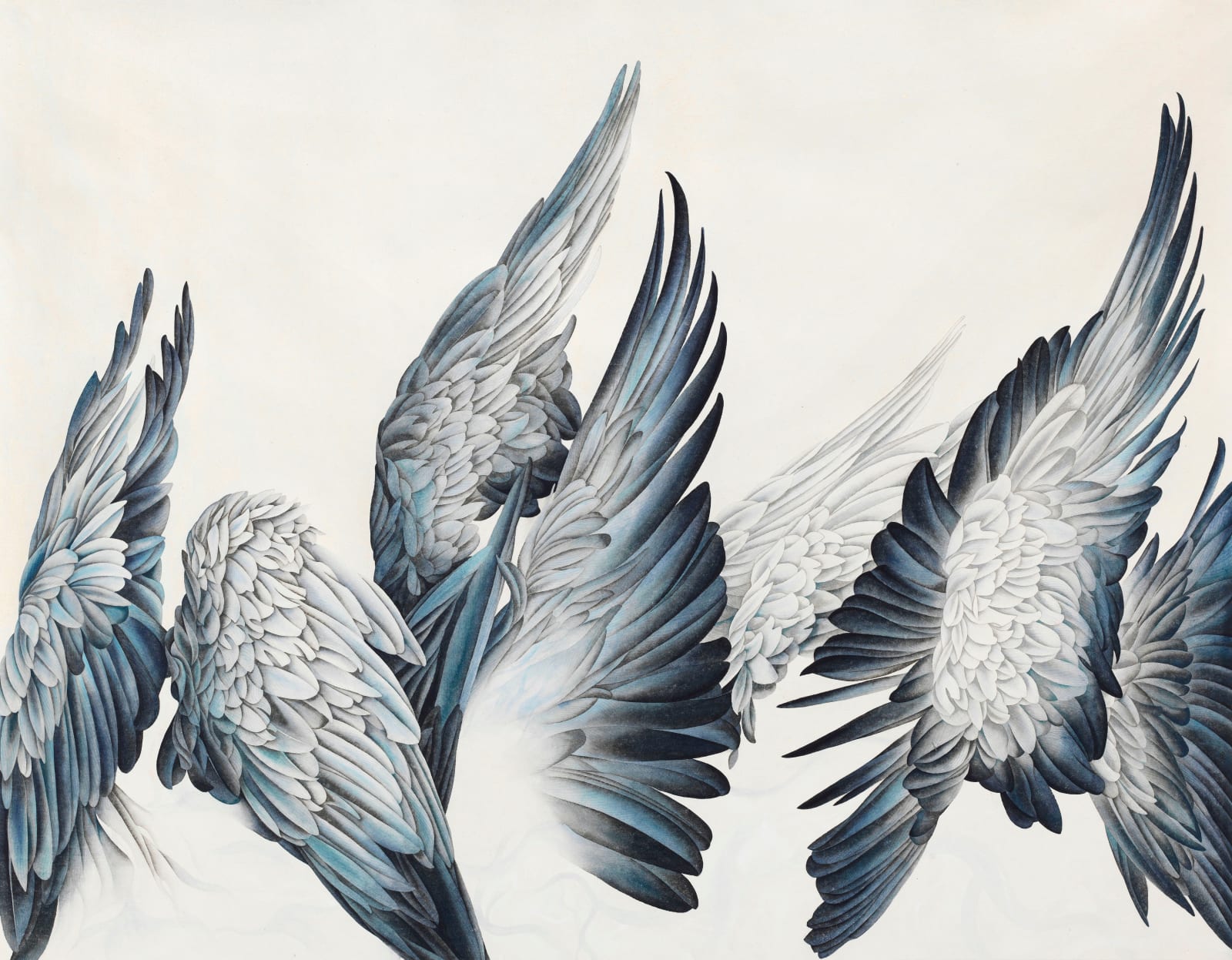Kang Chunhui 康春慧
The Hidden Protagonist No.3 隐逸的主角 No.3, 2023
Ink and mineral pigment on paper
水墨 矿物颜料 宣纸
水墨 矿物颜料 宣纸
88 x 115 cm
34 5/8 x 45 1/4 in
34 5/8 x 45 1/4 in
The Hidden Protagonist No. 3 is a meticulously crafted gongbi painting showcasing unfurling wings against an almost pristine white backdrop. While earlier avian portrayals often depicted birds in a state...
The Hidden Protagonist No. 3 is a meticulously crafted gongbi painting showcasing unfurling wings against an almost pristine white backdrop. While earlier avian portrayals often depicted birds in a state of apparent stillness (as seen in "Root of All Life · Lazuli") or with wings outstretched in a gesture of embrace (as in "Leda and the Swan", 2019), here, a sense of dynamic motion takes center stage, balancing delicacy with strength. The play of light on glossy feathers and the richness of blues are accentuated through stark contrasts between black and various shades of creamy and azure mineral pigments ground to varying degrees of fineness. Moreover, the intricate rendering of feathers with minute, precise calligraphic strokes evokes the meticulous detailing found in depictions of flower petals. In a fluid progression from earlier bird-themed paintings, this piece transcends conventional portrayal by omitting the birds' eyes, once conduits of emotional depth, as well as their heads and other body parts altogether. Through this selective exclusion, the artist accentuates the beauty, enigma, and tension of the composition, free from visual distractions. This deliberate choice directs attention to the overarching structure, unveiling a concealed protagonist imbued with an emotional lyricism impossible to articulate in words. With flowers metamorphosed into avian wings, the artwork visually echoes the silhouette of the Fuchun mountains, reminiscent of the renowned Chinese landscape painting "Dwelling in the Fuchunshan Mountains" by Yuan Dynasty master Huang Gongwang (1269-1354), celebrated as the pinnacle of traditional Chinese landscape art.
Commencing in late 2019, the Hidden Protagonist series embodies Kang's artistic pursuit of the sublime and enigmatic essence of nature. Through her artistic practice, she seeks not definitive answers but rather delves into the journey of uncovering the loftiest emotions inherent in human existence. In elucidating this concept, the artist reflects, “The 'protagonist' should be self-evident, yet simultaneously carries philosophical implications of 'existence,' as articulated by Heidegger: 'The question of existence not only lacks an answer, but even the question itself remains obscure and enigmatic.'”(1)
(1) Kang Chunhui (2022). About the Invisible Protagonist. Available at: An Art Space: https://mp.weixin.qq.com/s/aY6VUY7MT0L-mIHlH476Fg [Last accessed: 06 May, 2024].
《隐逸的主角No.3》是一幅细腻精致的工笔画作品,在近乎纯白的简洁背景下描绘出展开的翅膀,形态各异,灵动舒展。在康春慧早期的鸟类相关题材作品中,大多捕捉鸟的静态之姿(如《物云云 ·青》)或伸翅拥抱之态(如《丽达与天鹅》),但此幅作品却聚焦于展翅的活力与动态,展现优雅与力量的平衡之美。画面中的黑色与研磨至不同细腻程度的灰白及天蓝色矿物颜料之间形成鲜明的对比,凸显出羽毛在不同光线下所呈现出的不同光泽以及蓝色鲜艳而丰富的变化。此外,羽毛的刻画细致而繁复,细腻精确的书法笔法不禁让人联想到传统花卉画中对花瓣的细节描绘。
这件作品在早期鸟类主题画作的基础上进一步发展,突破了传统的描绘方式,将传达情感的眼睛,以及喙等其他身体部位通通省去。通过这种选择性省略,艺术家得以更好地突出构图的美感、神秘和张力,不受其他视觉因素的干扰。这一特定的选择将观者的注意力引向作品的整体结构,并揭开画面中“隐藏的主角”的神秘面纱,它充满了不能用言语表述的情感。画中翅膀与鸟羽的形态由花朵变化而来,而视觉上则与富春山的整体轮廓相呼应,令人联想到元代大师黄公望(1269-1354)那被誉为中国传统山水画巅峰之作的《富春山居图》。
《隐逸的主角》系列始于2019年底,体现了康春慧对大自然崇高而神秘本质的艺术探索。通过艺术实践,她所追寻的并非明确的答案,而是深入到追问人类最高情感的旅程之中。对于这一过程,康春慧曾解释道:“这位‘主角’应该是自明的,但同时也有哲学‘存在’的意义,如海德格尔所说‘存在问题不仅尚无答案,甚至这个问题本身还是晦暗和茫无头绪的’”。(1)
(1)康春慧,《关于隐逸的主角》,2022年。发表于《一甸艺术》:https://mp.weixin.qq.com/s/aY6VUY7MT0L-mIHlH476Fg(访问于2024年5月6日)。
Commencing in late 2019, the Hidden Protagonist series embodies Kang's artistic pursuit of the sublime and enigmatic essence of nature. Through her artistic practice, she seeks not definitive answers but rather delves into the journey of uncovering the loftiest emotions inherent in human existence. In elucidating this concept, the artist reflects, “The 'protagonist' should be self-evident, yet simultaneously carries philosophical implications of 'existence,' as articulated by Heidegger: 'The question of existence not only lacks an answer, but even the question itself remains obscure and enigmatic.'”(1)
(1) Kang Chunhui (2022). About the Invisible Protagonist. Available at: An Art Space: https://mp.weixin.qq.com/s/aY6VUY7MT0L-mIHlH476Fg [Last accessed: 06 May, 2024].
《隐逸的主角No.3》是一幅细腻精致的工笔画作品,在近乎纯白的简洁背景下描绘出展开的翅膀,形态各异,灵动舒展。在康春慧早期的鸟类相关题材作品中,大多捕捉鸟的静态之姿(如《物云云 ·青》)或伸翅拥抱之态(如《丽达与天鹅》),但此幅作品却聚焦于展翅的活力与动态,展现优雅与力量的平衡之美。画面中的黑色与研磨至不同细腻程度的灰白及天蓝色矿物颜料之间形成鲜明的对比,凸显出羽毛在不同光线下所呈现出的不同光泽以及蓝色鲜艳而丰富的变化。此外,羽毛的刻画细致而繁复,细腻精确的书法笔法不禁让人联想到传统花卉画中对花瓣的细节描绘。
这件作品在早期鸟类主题画作的基础上进一步发展,突破了传统的描绘方式,将传达情感的眼睛,以及喙等其他身体部位通通省去。通过这种选择性省略,艺术家得以更好地突出构图的美感、神秘和张力,不受其他视觉因素的干扰。这一特定的选择将观者的注意力引向作品的整体结构,并揭开画面中“隐藏的主角”的神秘面纱,它充满了不能用言语表述的情感。画中翅膀与鸟羽的形态由花朵变化而来,而视觉上则与富春山的整体轮廓相呼应,令人联想到元代大师黄公望(1269-1354)那被誉为中国传统山水画巅峰之作的《富春山居图》。
《隐逸的主角》系列始于2019年底,体现了康春慧对大自然崇高而神秘本质的艺术探索。通过艺术实践,她所追寻的并非明确的答案,而是深入到追问人类最高情感的旅程之中。对于这一过程,康春慧曾解释道:“这位‘主角’应该是自明的,但同时也有哲学‘存在’的意义,如海德格尔所说‘存在问题不仅尚无答案,甚至这个问题本身还是晦暗和茫无头绪的’”。(1)
(1)康春慧,《关于隐逸的主角》,2022年。发表于《一甸艺术》:https://mp.weixin.qq.com/s/aY6VUY7MT0L-mIHlH476Fg(访问于2024年5月6日)。

